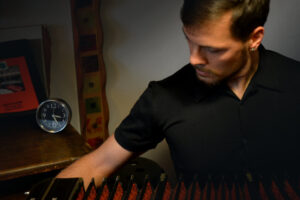
Optimizing Bandoneón Practice When Time is Short
Strategies to Perfect Bandoneón Practice There are times when musicians simply can’t dedicate as much time as they’d like to practicing, refining their skills, or
There are times when musicians simply can’t dedicate as much time as they’d like to practicing, refining their skills, or learning new material. When this happens, it’s easy to feel discouraged, or even tempted to quit altogether – to “hang up the bandoneón,” as we say.
After going through this very experience, I realized the problem wasn’t how much time I had, but rather how I was using it.
So, I started focusing on how to make the most of limited practice time. In other words, how to get the best results with an effective practice method. In this article, I’ll share some personal solutions I developed after months, even years, of disorganized practice.
These insights are all based on my own journey and personal growth. You see, with musical practice and study, you primarily learn how to study, and that’s a lifelong process.
The first step to making your time count is simply realizing you don’t have as much of it. It’s an acceptance that your available time and energy for practice have dwindled or are just plain limited.
I started to grasp that I was mismanaging my practice time several months after taking on a school role that demanded a lot of my energy and hours. My time availability had drastically changed, but I didn’t immediately catch on – perhaps too much optimism, or I just overestimated what I could handle.
I genuinely thought I could keep practicing the same way I always had, so I stuck to my old routine, believing it was effective. In reality, it was completely wrong for my new situation.
Months passed after I took on that role. Even though I was still practicing somewhat regularly (though for much shorter periods), one day it hit me that something was off. My musical progress felt slow, labored, and almost entirely unproductive.
That’s when my mind finally accepted the change, and I started thinking about how to practice smarter.
The second step was figuring out how I had been misusing my time, identifying the errors that were creating both psychological and practical roadblocks.
A good starting point is to think about how you’ve approached learning a piece of music so far. I put together a list of the mistakes I was making, which are probably pretty common.
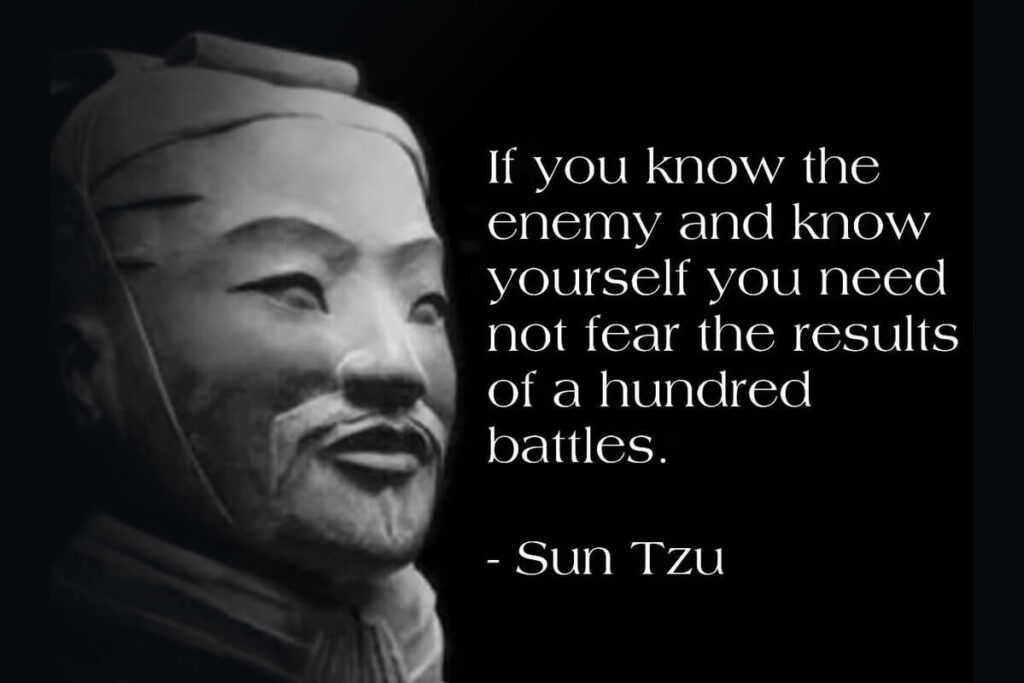
When I realized I was misusing my time, I felt like I was in a battle, disoriented by a seemingly unbeatable enemy. If you’re familiar with Sun Tzu and The Art of War, you know that to win – to achieve any objective – a winning strategy is crucial. Sun Tzu wrote: “If you know the enemy and know yourself, you need not fear the result of a hundred battles.”
Know the enemy: Here, the “enemy” represents bad practice habits, inefficient time management, and the mistakes you make without even realizing it. Recognizing these “enemies” is the first step to overcoming them.
Know yourself: This directly connects to understanding that you have less time and are using it poorly. It means understanding your own abilities, limitations, and resources (your available time and energy). It also involves realizing that through musical practice and study, you’re fundamentally learning how to learn.
You need not fear the result of a hundred battles: This translates to achieving your musical goals (the “victory”) even under tough conditions, without giving in to despair. Once you grasp how to practice effectively, you’ll be ready to face any challenge, even with limited time.
What follows are the steps of a possible optimization strategy that has worked for me over time, and which I’m still adapting and refining.
It’s absolutely essential to know how much time you have available during the week so you can plan your practice sessions.
Take an honest look at how much time you can realistically dedicate to practice each day. Even 15 minutes can make a difference; it might be enough to review a passage and solidify it in your memory.
It can be helpful to create a calendar with your available time slots throughout the week. This gives you a clear overview to better distribute your practice.
It’s incredibly important to choose a clear goal and estimate the time you’ll need to reach it. For instance, if you’ve decided to start a new piece, your goal might be to play it with some errors and inaccuracies within 3 weeks, and to play it reasonably well within the next 2 months.
My advice, though, is never to be too rigid with your timelines. If preparing a piece takes 4 months instead of 2, don’t sweat it. Estimating the time needed and “adjusting your aim” as you go along helps you better understand yourself and your current learning pace.
To avoid wasting energy, you need to decide what to study before you even start your practice session. My tip is to keep your daily plan as minimal as possible.
We’re constantly bombarded with the urge to do a million things a day. But the reality is, time is limited. So, it’s better to focus on studying one or two things a day, no more. As K. F. Gauss famously said, Pauca sed matura – Few things, but ripe. Focus on a few things, but go deep.
It’s really helpful to track your progress in a practice journal. Note down what you studied in each session, along with the date and time spent. You can also add observations about your practice, such as:
All this information will enrich your journal and keep you motivated to continue.
It’s crucial to play a first, rough version of the entire piece as soon as possible. This quickly helps you identify all the problems related to execution.
Technically, this first version of the piece should already include an understanding of the passages, the fingering, and, for the bandoneón, the bellows movements. Auditory-wise, this initial run-through allows you to hear what “comes out of your instrument” and get an idea of which passages sound off.
This preliminary version, even if still raw, is what we call the primer armado (first assembly) in the jargon I learned at the Buenos Aires Conservatory. It’s your starting point for all subsequent practice.
It’s essential to reach a first, complete, even if imprecise, version as quickly as possible. In my experience, having an overall view of the piece right away and identifying the main technical and performance issues is incredibly important.
To help build this “primer armado,” I’ve found it immensely useful to listen to different existing recordings of the same piece. You can do this anytime, even when you’re not actively practicing—for example, while reaching your workplace. Consciously listening to the piece you want to play helps you understand its structure, memorize the melody and accompaniment. This way, you’ll have to fight less with the notes on the sheet music trying to figure out what you’re playing.
Memorizing a piece as quickly as possible is vital, provided that the memorization is solid and effective from the very beginning.
Solid memorization doesn’t rely on short-term memory or fleeting muscle memory (the so-called “hands memory”).
To memorize a piece effectively, you absolutely need a progressive and planned approach based on sections. By section, I mean any part of the piece that can be isolated for study. This is a flexible concept: a section can be short or long depending on your needs, and it can be expanded or reduced. Initially, sections will be short (a measure or even less) and will gradually grow, until the entire piece becomes one large section. You should repeat the study of each section until you’ve memorized it and can play it correctly (fijación).
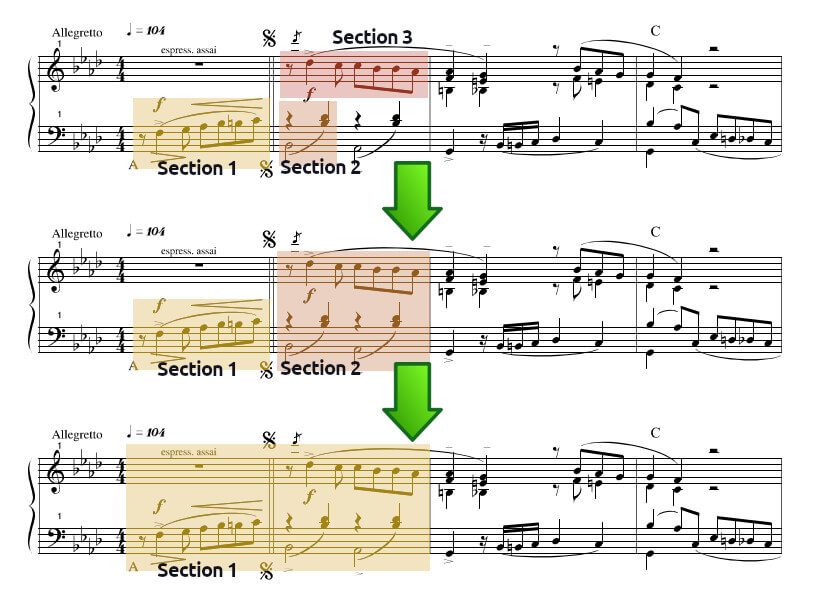
There are several ways to improve and test your memorization of a piece or a section. One effective method is to deliberately change the way you play it.
After you’ve got a first complete version of the piece (primer armado), it’s incredibly helpful to revisit it by altering certain variables, such as playing speed (slower, faster, etc.), dynamics (louder, softer, etc.), and articulation (staccato, legato, etc.).
Each new time you study the piece, you’re creating a new version (nuevo armado), and each new version deepens your understanding and memory of the piece. There are countless possible versions. Revisiting the study of sections truly solidifies your fijación.
Singing the melody or the voice lines of a piece significantly improves both memorization and understanding. You don’t need to sing like Freddie Mercury; just correctly identify the musical intervals and sing them in tune.
Ralph Kirkpatrick wrote in Interpreting Bach’s Well-Tempered Clavier: “In dealing with pupils, I have often found that passages not well fixed in the memory were those which had not been clearly heard.”
Finally, understanding the formal and theoretical elements of music also aids conscious memory. I’m talking about form and structure, harmony, counterpoint, and the specific musical elements used (cadences, scales, arpeggios, intervals, etc.). Studying music theory should always go hand-in-hand with playing your instrument.
When a section of a piece is particularly challenging, forcing it can be completely ineffective and even counterproductive. “Difficult” passages in a piece, from a performance perspective, are usually linked to incorrect posture or a temporary lack of preparation in your mind-body system.
If a technically difficult passage seems impossible to fix, it’s very likely because you’re persisting with an inefficient posture that restricts or blocks certain movements. Try changing the “variables” that create and control the movement.
For example, for the bandoneón, try adjusting the position of your:
Also, check for any unnecessary tension, which commonly shows up in the neck. Get rid of that extra tension and focus your movement on the specific technical action you need to perform. You might consider seeking help from an Alexander Technique expert or someone skilled in any other method aimed at improving mind-body awareness.
Sometimes, even after improving your posture and eliminating unnecessary tension, you still can’t achieve the desired result. In such cases, you need to give your psychomotor system time to internalize the new movement.
Again, for the bandoneón, your hand needs to open up and become flexible, your wrist needs to loosen, and your fingers need to learn to properly calibrate the pressure on the keys, and so on. In these situations, it’s advisable not to obsess over that section. Instead, allow your body to gradually get used to the new movement.
Once a piece is reasonably prepared, it’s very helpful to test it by simulating the pressure of a public performance.
You can simulate public pressure in several ways. Ask some friends to listen to you, or organize a mini-home concert. Alternatively, you can record yourself with your phone or a video camera.
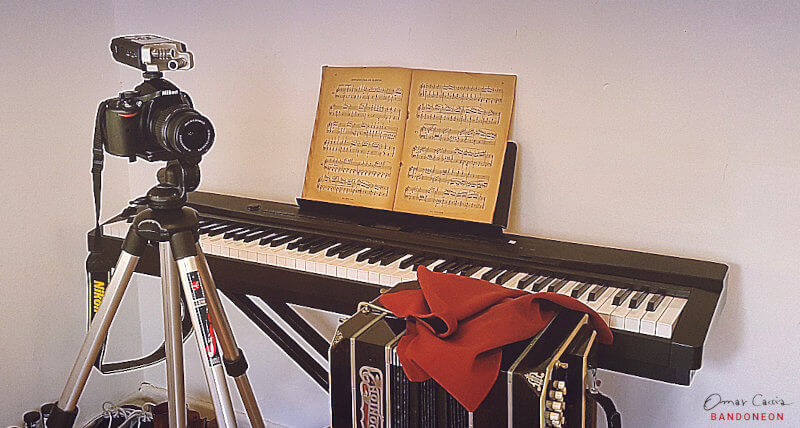
You’ll quickly find that the passages that don’t hold up under pressure are usually the ones that need revisiting or more in-depth practice.
You don’t need to play an entire piece or an entire concert to do this test. Just one piece, or even parts of it, is enough.
Don’t make the common mistake (which I’ve also made) of thinking that a piece has to be “perfect” before you can perform it publicly. That’s a completely flawed idea. The concept of perfection is totally relative. The more you study a piece, the better you’ll know it, and the more you’ll realize you’ll keep refining it for your entire life.
Being able to play a piece correctly is just the beginning of the study process.
It’s easy to assume you have too little time when in reality you’re just using it poorly due to a lack of concentration. I find this quite normal when you’re doing an activity repeatedly for a long time.
Practicing without focus or clear goals can give you the false impression that time is scarce, when it’s actually sufficient but you’re simply not using it effectively.
Practicing with concentration, on the other hand, means having clear objectives and knowing how to achieve them.
A quick tip: when you’re practicing, put your cell phone, computer, and social media offline. They are a constant source of distraction. Carve out your own space just for you and leave the world outside.
Without a doubt, the most important factor is willpower. Without it, everything I’ve discussed so far becomes pointless.
Let’s be honest: time isn’t the problem. Anyone who truly desires a result will find the time.
As an example and inspiration, I’d like to mention jazz guitarist Wes Montgomery. During the day, he worked as a welder in a workshop, and he practiced guitar at night. If that’s not iron will, what is?
The moment musicians realize their practice time has drastically shrunk can feel like a real crisis. We often give that word a negative spin, but its original meaning points to decision, choice, and by extension, change.
So, having less time can actually become an opportunity to rethink our entire approach to practice.
Learning to optimize your available time means you can achieve more in less time than you would with less effective practice. And at that point, the quality of your practice will drastically improve.
In principle, I believe everything discussed in this article can apply to any field, not just music study.

Strategies to Perfect Bandoneón Practice There are times when musicians simply can’t dedicate as much time as they’d like to practicing, refining their skills, or

The project Duruflé meets the Bandoneón proposes an innovative exploration of the music of the great French composer Maurice Duruflé through the bandoneón, an instrument

In this bandoneón tutorial I explain the first of a series of preparatory exercises. After having dedicated a series of videos to the fundamental aspects

Learn about chromatic bandoneons! Download FREE PDF keyboard layouts for Peguri, Manoury, & Crosio-Caliero systems. Unisonoric bandoneon explained for beginners.

A Lesson from the Bandoneon to Move from Stage Panic to Expressiveness 2024 is coming to an end and I have been very busy during
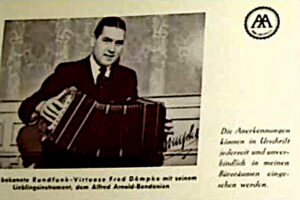
Who is Fred Dömpke and why should deserve more consideration among the bandoneon players? The bandoneon is conquering a significant role in jazz. Many bandoneon